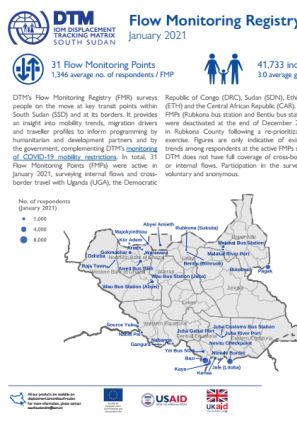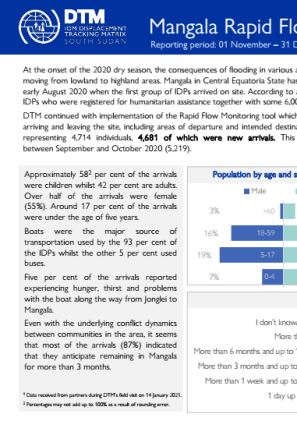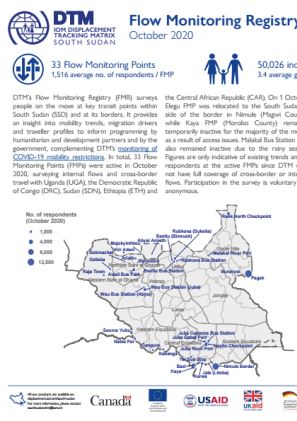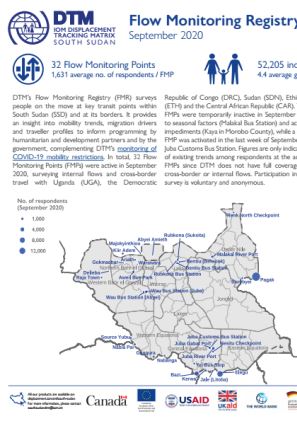-
Countries
-
Data and Analysis
-
Special Focus
-
Crisis Responses
Flow Monitoring Dashboard / Dataset
Country
Title Standard
South Sudan — Flow Monitoring Dataset / Dashboard ({DATE})
Operation
Contact
DTM South Sudan, SouthSudanDTM@iom.int
Type
Component
Confidential

Contact
DTM South Sudan, SouthSudanDTM@iom.int
Language
English
Location
South Sudan
Period Covered
Oct 01 2020
Dec 31 2020
Activity
- Flow Monitoring
IOM’s Displacement Tracking Matrix (DTM) continued operating Displacement Site Flow Monitoring (DSFM) at the gates of Malakal Protection of Civilians (PoC) site. During this period, 3,270 interviews were conducted representing 4,964 individual movements in to and out of the site. There was a 12 per cent decrease in surveyed day movements relative to July - September, most of which are for farming / fishing and other livelihood activities. Longer temporary travel is primarily for family reasons and livelihood activities, with 38 per cent of such movements lasting less than a week although another 30 per cent last more than six months. Women and girls are over-represented among both same day and temporary travelers. The number of surveyed new arrivals, over half of whom intend to stay more than six months, decreased slightly relative to the previous quarter (229 compared to 247), with most joining family (55%) or seeking access to healthcare (22%). Surveyed permanent exits decreased from 90 to 30, almost all of whom traveled to join family in areas of return or relocation.

Contact
DTM South Sudan, SouthSudanDTM@iom.int
Language
English
Location
South Sudan
Period Covered
Oct 01 2020
Dec 31 2020
Activity
- Flow Monitoring
IOM’s Displacement Tracking Matrix (DTM) continued operating Displacement Site Flow Monitoring (DSFM) at the gates of Wau Masna Collective Centre. In the last quarter of 2020 (October - December), 1,804 interviews were conducted, representing 4,465 individual movements. This quarter recorded a 13 per cent decrease in surveyed day movements relative to July - September, most of which are to buy things, visit friends or relatives, livelihood activities and access to healthcare services. Temporary movement is primarily to visit friends or family, check on or repair property, and access to healthcare services, with 44 per cent of such movements lasting less than a week. There were 24 new arrivals, an 83 per cent decrease compared to previous quarter, all of whom came to join family and over half of whom intend to stay two to four weeks at the centre. Surveyed permanent exits decreased from 31 to 10, all of whom traveled to join family in areas of return.

Contact
DTM South Sudan, SouthSudanDTM@iom.int
Language
English
Location
South Sudan
Period Covered
Oct 01 2020
Dec 31 2020
Activity
- Flow Monitoring
IOM’s Displacement Tracking Matrix (DTM) continued operating Displacement Site Flow Monitoring (DSFM) at the gates of Naivasha IDP camp. During this period, 2,111 interviews representing 8,296 individual movements in to and out of the camp were conducted. There has been a 26 per cent decrease in surveyed day movements relative to July - September, most of which are for livelihood activities and family reasons. Temporary movements on the other hand are primarily for family reasons and attempting to return home, with six out of fifteen of such movements lasting more than six months. The number of surveyed new arrivals, over half of whom intend to stay for four to six months, decreased to 21 compared to 83 in the previous quarter. Most of these movements were due to insecurity because of conflict (76%) and joining family (10%). Lastly, surveyed permanent exits decreased from 110 to 71, almost all of whom traveled because of improved circumstances at destination.

Contact
DTM South Sudan, SouthSudanDTM@iom.int
Language
English
Location
South Sudan
Period Covered
Jan 01 2021
Jan 31 2021
Activity
- Flow Monitoring
DTM’s Flow Monitoring Registry (FMR) surveys people on the move at key transit points within South Sudan (SSD) and at its borders. It provides an insight into mobility trends, migration drivers and traveller profiles to inform programming by humanitarian and development partners and by the government, complementing DTM’s monitoring of COVID-19 mobility restrictions. In total, 31 Flow Monitoring Points (FMPs) were active in January 2021, surveying internal flows and crossborder travel with Uganda (UGA), the Democratic Republic of Congo (DRC), Sudan (SDN), Ethiopia (ETH) and the Central African Republic (CAR). Two FMPs (Rubkona bus station and Bentiu bus station) were deactivated at the end of December 2020 in Rubkona County following a re-prioritization exercise. Figures are only indicative of existing trends among respondents at the active FMPs since DTM does not have full coverage of cross-border or internal flows. Participation in the survey is voluntary and anonymous.
Please click here to access the dataset.

Contact
DTM South Sudan, SouthSudanDTM@iom.int
Language
English
Location
South Sudan
Period Covered
Feb 01 2020
Dec 31 2020
Activity
- Flow Monitoring
Building on its global expertise in emergency data collection systems, including in response to previous infectious disease outbreaks, IOM’s Displacement Tracking Matrix (DTM) has been monitoring the impact of COVID-19 travel restrictions on human mobility on a global scale. In South Sudan, DTM has been implementing flow monitoring and remote assessments at points of entry to ‘inform the wider response by generating and analysing information on mobility’, a strategic priority set out by the National COVID-19 Response Plan for the Points of Entry pillar. This report makes use of flow monitoring data to analyse the short and medium term impact of COVID-19 travel restrictions on cross-border mobility.

Contact
DTM South Sudan, SouthSudanDTM@iom.int
Language
English
Location
South Sudan
Period Covered
Nov 01 2020
Dec 31 2020
Activity
- Other
- Flow Monitoring
At the onset of the 2020 dry season, the consequences of flooding in various areas of South Sudan continue to be deeply felt. Many people are still displaced after moving from lowland to highland areas. Mangala in Central Equatoria State has been a locus of flood-related displacement and other population movements since early August 2020 when the first group of IDPs arrived on site. According to available data from the World Food Programme (WFP), the site hosts more 24,500 IDPs who were registered for humanitarian assistance together with some 6,000 host community members in need of support. DTM continued with the implementation of the Rapid Flow Monitoring tool which supplies partners with the number of new arrivals and basic profile of populations arriving and leaving the site, including areas of departure and intended destinations. Between 1 November and 31 December 2020, DTM surveyed 692 groups representing 4,714 individuals, 4,681 of which were new arrivals. This is a 10 per cent decrease of arrivals at the port compared to the period between September and October 2020 (5,219).

Contact
DTM South Sudan, SouthSudanDTM@iom.int
Language
English
Location
South Sudan
Period Covered
Dec 01 2020
Dec 31 2020
Activity
- Flow Monitoring
DTM’s Flow Monitoring Registry (FMR) surveys people on the move at key transit points within South Sudan (SSD) and at its borders. It provides an insight into mobility trends, migration drivers and traveller profiles to inform programming by humanitarian and development partners and by the government, complementing DTM’s monitoring of COVID-19 mobility restrictions. In total, 33 Flow Monitoring Points (FMPs) were active in December 2020, surveying internal flows and cross-border travel with Uganda (UGA), the Democratic Republic of Congo (DRC), Sudan (SDN), Ethiopia (ETH) and the Central African Republic (CAR). Activities at Renk North Checkpoint remained suspended in December due to ongoing insecurity. Figures are only indicative of existing trends among respondents at the active FMPs since DTM does not have full coverage of cross-border or internal flows. Participation in the survey is voluntary and anonymous.
Please click here to access the dataset.

Contact
DTM South Sudan, SouthSudanDTM@iom.int
Language
English
Location
South Sudan
Period Covered
Nov 01 2020
Nov 30 2020
Activity
- Flow Monitoring
DTM’s Flow Monitoring Registry (FMR) surveys people on the move at key transit points within South Sudan (SSD) and at its borders. It provides an insight into mobility trends, migration drivers and traveller profiles to inform programming by humanitarian and development partners and by the government, complementing DTM’s monitoring of COVID-19 mobility restrictions. In total, 34 Flow Monitoring Points (FMPs) were active in November 2020, surveying internal flows and cross-border travel with Uganda (UGA), the Democratic Republic of Congo (DRC), Sudan (SDN), Ethiopia (ETH) and the Central African Republic (CAR). Malakal Bus Station and Kaya FMPs resumed operations on 3 and 12 November, while Renk North Checkpoint FMP suspended operations since 20 November as a result of security issues. Figures are only indicative of existing trends among respondents at the active FMPs since DTM does not have full coverage of cross-border or internal flows. Participation in the survey is voluntary and anonymous.
Please click here to access the dataset.

Contact
DTM South Sudan, SouthSudanDTM@iom.int
Language
English
Location
South Sudan
Period Covered
Oct 01 2021
Oct 31 2021
Activity
- Flow Monitoring
DTM’s Flow Monitoring Registry (FMR) surveys people on the move at key transit points within South Sudan (SSD) and at its borders. It provides an insight into mobility trends, migration drivers and traveller profiles to inform programming by humanitarian and development partners and by the government, complementing DTM’s monitoring of COVID-19 mobility restrictions. In total, 33 Flow Monitoring Points (FMPs) were active in October 2020, surveying internal flows and cross-border travel with Uganda (UGA), the Democratic Republic of Congo (DRC), Sudan (SDN), Ethiopia (ETH) and the Central African Republic (CAR). On 1 October Elegu FMP was relocated to the South Sudanese side of the border in Nimule (Magwi County), while Kaya FMP (Morobo County) remained temporarily inactive for the majority of the month as a result of access issues. Malakal Bus Station FMP also remained inactive due to the rainy season. Figures are only indicative of existing trends among respondents at the active FMPs since DTM does not have full coverage of cross-border or internal flows. Participation in the survey is voluntary and anonymous.
Please click here to access the dataset.

Contact
DTM South Sudan, SouthSudanDTM@iom.int
Language
English
Location
South Sudan
Period Covered
Sep 01 2020
Sep 30 2020
Activity
- Flow Monitoring
DTM’s Flow Monitoring Registry (FMR) surveys people on the move at key transit points within South Sudan (SSD) and at its borders. It provides an insight into mobility trends, migration drivers and traveller profiles to inform programming by humanitarian and development partners and by the government, complementing DTM’s monitoring of COVID-19 mobility restrictions. In total, 32 Flow Monitoring Points (FMPs) were active in September 2020, surveying internal flows and cross-border travel with Uganda (UGA), the Democratic Republic of Congo (DRC), Sudan (SDN), Ethiopia (ETH) and the Central African Republic (CAR). Two FMPs were temporarily inactive in September due to seasonal factors (Malakal Bus Station) and access impediments (Kaya in Morobo County), while a new FMP was activated in the last week of September at Juba Customs Bus Station. Figures are only indicative of existing trends among respondents at the active FMPs since DTM does not have full coverage of cross-border or internal flows. Participation in the survey is voluntary and anonymous.
Please click here to access the dataset.
Pagination
- Previous page
- Page 2
- Next page
